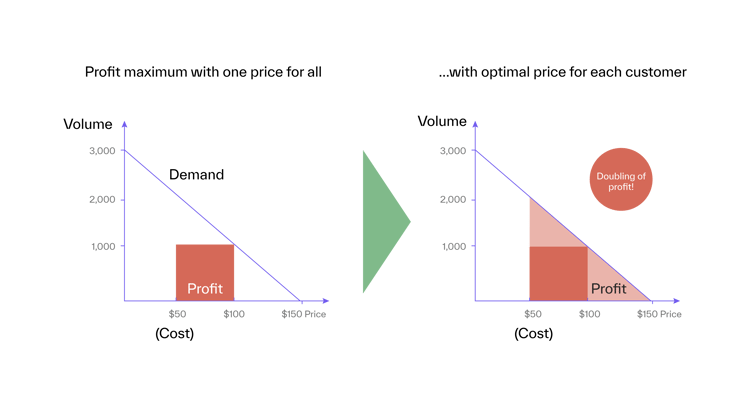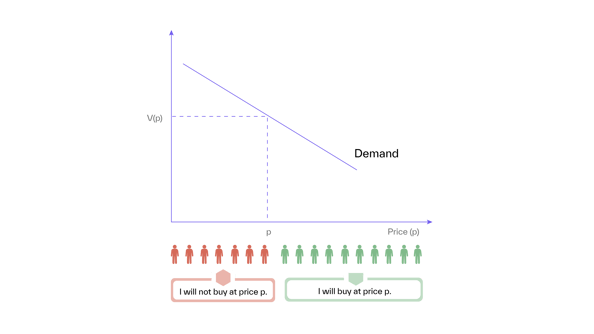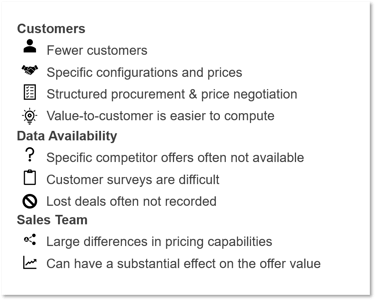
Figure 4: Difference in profit between a single price and the maximum price for all customers
Read our latest whitepaper, "Generative AI for Revenue Growth Management (RGM)"
Why care about B2B pricing?
B2B pricing is a large field, it deals the pricing towards business customers. Naively, the difference between B2C (business to consumer) and B2B (business to business) is captured in the two pictures in Figure 1. Consumers tend to purchase more spontaneously and emotionally, while businesses’ purchase decisions are more rational and follow a planned process.

Figure 1: B2C vs. B2B pricing
But what does this imply for pricing? In this first blog of our B2B pricing series, we provide an overview of the specific challenges to B2B pricing by looking at B2C pricing roots and then highlighting how the specifics of B2B affect pricing.
Pricings’ B2C roots
Most pricing concepts have, at least implicitly, a consumer on the demand side in mind. For example, the assumption in classical economics that demand functions are continuous and differentiable is needed to compute the price elasticity – and it implies many atomistic buyers, each with only minimal relevance (see Figure 2).

Figure 2: Market equilibrium in classical economics
Competitive pricing, i.e. pricing relative to key competitors, is very common in B2C. Particularly in online retail, where competitor prices are easily collected by price crawlers, competitive pricing is omnipresent. In B2B, on the other hand, competitors’ offers, and prices are generally not transparent and are therefore difficult to consider for price decisions.
Measuring customers’ willingness to pay via large-scale studies is a viable option for consumer products, but very difficult for B2B products, as relevant participants for such studies are difficult to find and interview. Moreover, the relevance of business customers is often highly skewed with few key accounts comprising the majority of sales. That is why – for example – conjoint studies are much less common in B2B and assessments of customers’ preferences and the value they attribute to a product often rely much more heavily on expert judgement and gut feeling.
Together, these reasons make a direct application of many pricing tools such as price elasticities or value pricing difficult in B2B.
B2C vs. B2B pricing: Same, same, but different!
B2B pricing is not limited to a few industries; it covers a large variety of diverse products and services including professional services e.g., from lawyers or accountants, software, machinery, or logistics, in short, everything, businesses need to flourish. Overall, these applications vary greatly, but in terms of pricing, they also have a lot in common that is important. Figure 3 summarizes the key common factors of B2B pricing.

Figure 3: Common characteristics of B2B sales
Essentially, in B2B pricing, customer specifics matter more than in B2C. This is because companies tend to have much fewer B2B customers, and these have specific needs that need to be addressed in configuring offers and setting prices. On the other hand, the value a product or service provides to a business customer, be it in the form of a saving or an increase in sales, is often easier to assess than the willingness-to-pay of consumers.
Furthermore, relevant pricing data is often unavailable. Not only customer insights (e.g., from conjoint studies) and competitor price information, but also proper sales data is often unavailable in B2B companies. For example, many companies do not systematically collect data on their lost deals. However, together with the won deals, this provides crucial insights for pricing. Simply, to get the price right, you need to know, when it has been too high in the past. A sales rep with a high average selling price might be losing too many deals and is not a good reference point for others.
Additionally, the impact of the company’s sales team on pricing is often difficult to assess. If different sales managers achieve different prices for the same products, this can result from differences in their customer bases, differences in their pricing and negotiation capabilities – or from differences in the value they provide to their customers.
For example, one saleswoman solves her customers’ business challenges 24/7, while her colleague does not. Consequently, her customers are willing to pay a premium for the products she sells. Such differences have strong implications for pricing. Then, should sales representatives have different price targets dependent on the extra value they provide to customers?
Due to the large differences between business customers’ needs and the non-transparency of competitors’ offers and prices, differentiation has become the central theme in B2B pricing.

Figure 4: Difference in profit between a single price and the maximum price for all customers

Hohenzollernring 89-93
50672 Cologne
Germany
info@buynomics.com